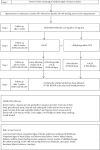Government-Expert Joint Intervention with Treatment Algorithm and Improved Hypertension Management and Reduced Stroke Mortality in a Primary-Care Setting
- PMID: 34691775
- PMCID: PMC8531792
- DOI: 10.1155/2021/9661576
Government-Expert Joint Intervention with Treatment Algorithm and Improved Hypertension Management and Reduced Stroke Mortality in a Primary-Care Setting
Abstract
Hypertension management is suboptimal in the primary-care setting of developing countries, where the burden of both hypertension and cardiovascular disease is huge. Therefore, we conducted a government-expert joint intervention in a resource-constrained primary setting of Emin, China, between 2014 and 2016, to improve hypertension management and reduce hypertension-related hospitalization and mortality. Primary-care providers were trained on treatment algorithm and physicians for specialized management. Public education was delivered by various ways including door-to-door screening. Program effectiveness was evaluated using screening data by comparing hypertension awareness, treatment, and control rates and by comparing hypertension-related hospitalization and total cardiovascular disease (CVD) and stroke mortality at each phase. As results, 313 primary-health providers were trained to use the algorithm and 3 physicians attended specialist training. 1/3 of locals (49490 of 133376) were screened. Compared to the early phase, hypertension awareness improved by 9.3% (58% vs. 64%), treatment by 11.4% (39% vs. 44%), and control rates by 33% (10% vs. 15%). The proportion of case/all-cause hospitalization was reduced by 35% (4.02% vs. 2.60%) for CVD and by 17% (3.72% vs. 3.10%) for stroke. The proportion of stroke/all-cause death was reduced by 46% (21.9% in 2011-2013 vs. 15.0% in 2014-2016). At the control area, the proportion of case/all-cause mortality showed no reduction. In conclusion, government-expert joint intervention with introducing treatment algorithm may improve hypertension control and decrease related hospitalization and stroke mortality in underresourced settings.
Copyright © 2021 Mulalibieke Heizhati et al.
Conflict of interest statement
The authors declare no conflicts of interest.
Similar articles
-
Effects of Simplified Antihypertensive Treatment Algorithm on Hypertension Management and Hypertension-Related Death in Resource-Constricted Primary Care Setting between 1997 and 2017.Int J Hypertens. 2021 Jul 13;2021:9920031. doi: 10.1155/2021/9920031. eCollection 2021. Int J Hypertens. 2021. PMID: 34336267 Free PMC article.
-
Changes in blood pressure among users of lay health worker or volunteer operated community-based blood pressure programs over time: a systematic review protocol.JBI Database System Rev Implement Rep. 2015 Oct;13(10):30-40. doi: 10.11124/jbisrir-2015-1927. JBI Database System Rev Implement Rep. 2015. PMID: 26571280
-
Community-based care for the specialized management of heart failure: an evidence-based analysis.Ont Health Technol Assess Ser. 2009;9(17):1-42. Epub 2009 Nov 1. Ont Health Technol Assess Ser. 2009. PMID: 23074521 Free PMC article.
-
Pharmacotherapy for hypertension in adults 60 years or older.Cochrane Database Syst Rev. 2019 Jun 5;6(6):CD000028. doi: 10.1002/14651858.CD000028.pub3. Cochrane Database Syst Rev. 2019. PMID: 31167038 Free PMC article.
-
Prognostic interactions between cardiovascular risk factors.Dan Med J. 2014 Jul;61(7):B4892. Dan Med J. 2014. PMID: 25123126 Review.
References
-
- Global Status Report on Noncommunicable Diseases 2010 . Geneva, Switzerland: World Health Organization; 2011.
-
- A Global Brief on Hypertension . Geneva, Switzerland: World Health Organization; 2013.
LinkOut - more resources
Full Text Sources
Research Materials


